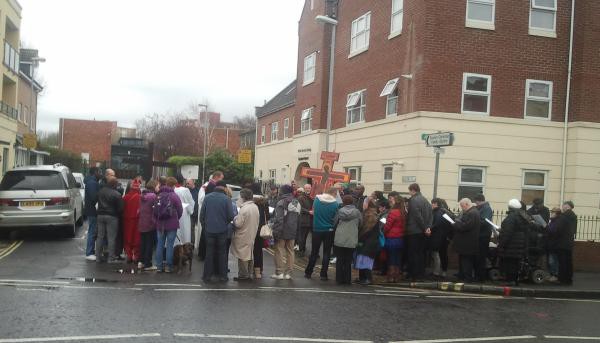The weather is warming up, summer migrant birds are returning to the UK to breed in the trees, shrubs and other traditional nesting sites; and as regular as clockwork, Bristol City Council sends workmen out to destroy those same traditional nesting sites, as witnessed this morning at the junction of Lawrence Hill and Croydon Street.

During the few minutes it took me to buy a tin of coffee up the road, the two trunks seen standing in the photo had been felled, joining a previously felled companion. All three felled were – as far as I could see – healthy specimens.
As regards protecting breeding birds and mitigating harm during the breeding season, Natural England’s advice (PDF, p. 4) is as follows:
The main mitigation route to reduce the likelihood of harm to breeding birds is to undertake clearance or destruction of any vegetation or structure which may be used as a breeding site outside the bird breeding season when breeding birds are unlikely to be present (based upon habitat features) or where survey work has confirmed their absence. Avoidance of such features is best achieved through timing of work (see below) but may also be possible by temporarily preventing birds from using these features, before they start doing so. Examples include physical exclusion (preventing access to potential nest sites) or use of visual or audible deterrents. Such measures should only be undertaken following the advice of a suitably experienced ecologist, taking account of relevant legislation and welfare considerations.
The bird breeding season will be dependent upon weather conditions and will vary from year to year, but in general is the period between early March and late August.
Natural England acts as an adviser to central government on the natural environment, providing practical science-based advice on how best to safeguard England’s natural wealth for the benefit of all.
By carrying out such works at this time of year, Bristol City Council is not only disregarding the advice given by Natural England, but also its own advice which it gives to community groups (PDF) carrying out conservation works involving trees. Page 2 of this document clearly states in relation to coppicing that this should be carried out between October and February. In the exact words of the guidance (page 2), this
Should be done during the dormant season and outside the bird nesting season.
In another city council document (PDF) entitled Tree Management Standards, page 4 clearly states:
Nesting birds are protected under the Wildlife and Countryside Act (and other related wildlife law).
All this is happening in the year when Bristol is allegedly European Green Capital. However, the city council seems more interested in press stunts than in sound environmental practice that protects the environment and wildlife.
Readers with long-term memories may remember that scrub clearance took place last year nearby at Lawrence Hill roundabout (posts passim).
![]()



 On Friday 24th April 2015, the
On Friday 24th April 2015, the 






